smacdonald
Well-Known Member
Hi all,
This the final installment from my WA trip. Earlier episodes:
The Pinnacles and Lesueur National Park
Numbat alert!
Perth Zoo
Tiger snakes
Into the Rat's nest
Shark Bay
Monkey Mia and Hamelin Pool
Cape Range National Park and Exmouth
In this exciting episode, join our intrepid adventurers as they battle dragons, serpents, the public health system and much, much more!
On the way from Cape Range to Karijini we drove though a lot of spinifex country and saw a number of dragons dashing off the road as we went by. We stopped and tracked one down to find it was a ring-tailed dragon (Ctenophorus caudicinctus).
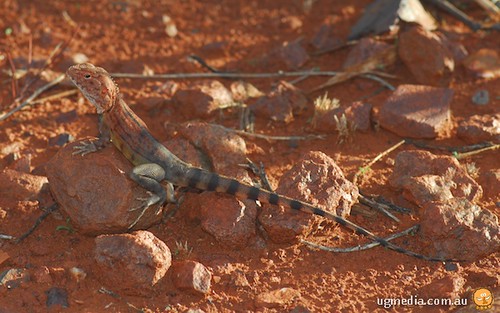
Ring-tailed dragon (Ctenophorus caudicinctus).
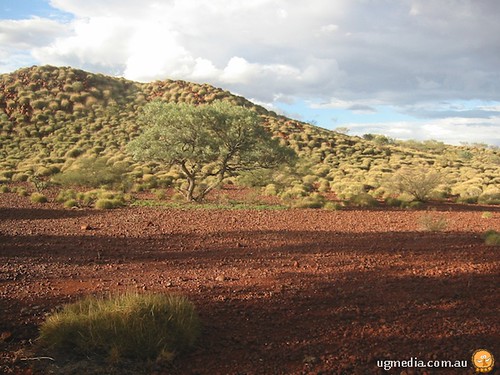
Ring-tailed dragon (Ctenophorus caudicinctus) habitat.
On the way into Tom Price (the town closest to Karijini) we had a look at a lookout. At the top were piles of rocks with 'in memoriam' inscriptions on them. These rocks are apparently placed here to honour those that have died in the local mines.
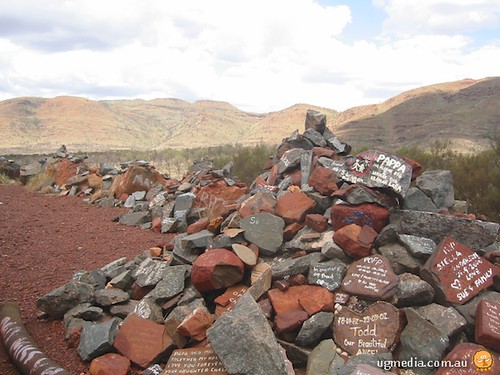
A rock pile memorial on top of a hill near Tom Price. The writings on the rocks honour those people who have died in the nearby mines.
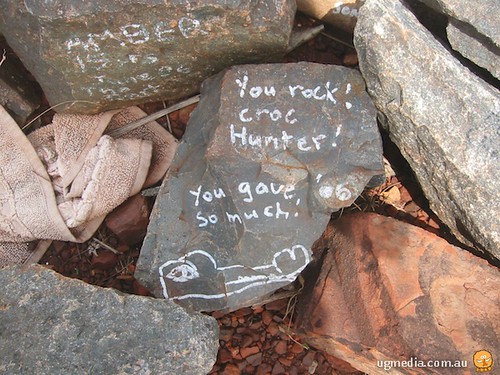
Some rocks honour other, non-mining related tragedies..
The sun went down before we got to town, so we drove the last 30 minutes or so in the dark. This worked out well as we saw a number of cool reptiles on the road, including the other snake I'd come to Western Australia for, the pygmy python (Antaresia perthensis).
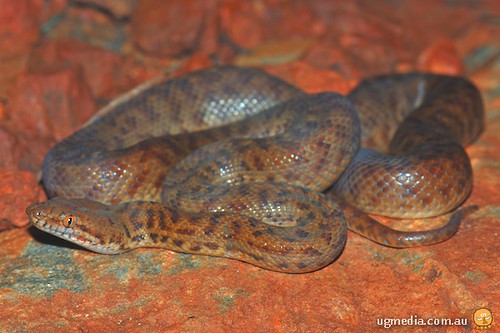
Pygmy python (Antaresia perthensis), the world's smallest python..
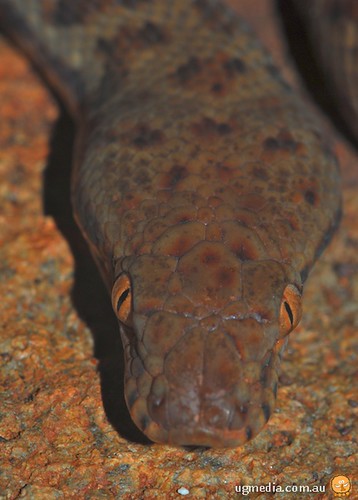
Pygmy python (Antaresia perthensis).
I also added another spiny-tailed gecko to my list when we found a Strophurus wellingtonae.
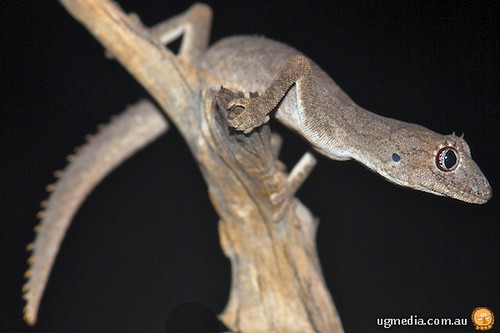
Strophurus wellingtonae.
Sadly, there were a number of dead or dying snakes on the road, such as a western brown snake (Pseudonaja nuchalis) and this orange-naped snake (Furina ornata).
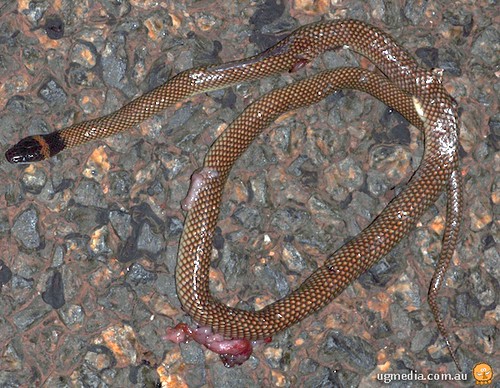
Road-killed orange-naped snake (Furina ornata).
We also found a still-writhing Pilbara death adder (Acanthophis wellsi).
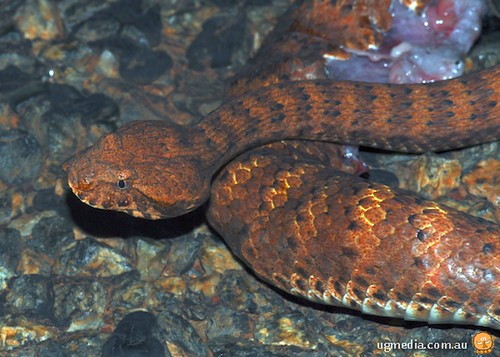
This Pilbara death adder (Acanthophis wellsi) had just been hit by a car. We crushed its head to put it down..
Dean grabbed a nearby rock and went to crush its head to put it out of its misery. As he did so, the snake flinched and brushed against his hand. We weren't sure if he'd been bitten or not, so we bandaged his arm and headed to the Tom Price hospital. Thankfully we were only a few minutes away from town by this stage. We rocked up at the hospital and told them they story. Dean wasn't showing any signs of envenomation so they took the bandage off and monitored his vital signs. After a few minutes of normality the nurse was satisfied that Dean hadn't been bitten, so we left.
It was a bit late to make it to Karijini so we headed to the nearby caravan park and set up camp. Because we'd had such a good haul on the road we decided to head back out and see what else was active. We soon came across a sleeping ring-tailed dragon (Ctenophorus caudicinctus).
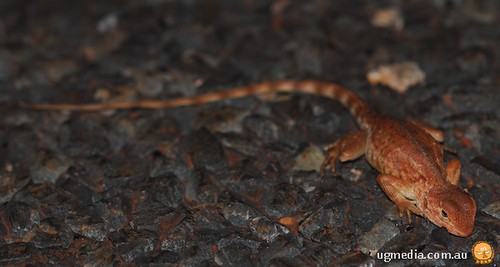
Ring-tailed dragons (Ctenophorus caudicinctus) often sleep on the road at night..
As we were photographing it Dean saw a snake crossing the road ahead so we all sprinted up to find a beautifully patterned Stimson's python (Antaresia stimsoni) arcing up in our presence.
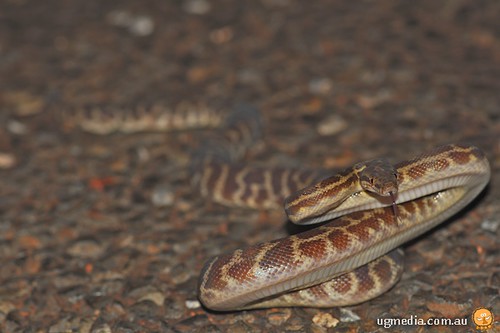
Stimson's python (Antaresia stimsoni).
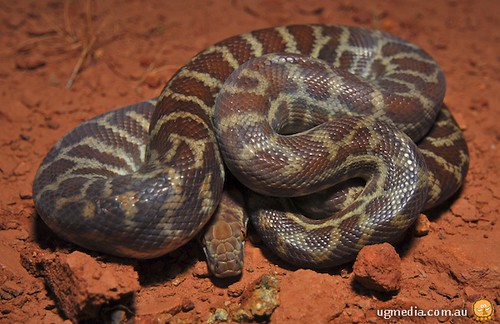
Stimson's python (Antaresia stimsoni).
Back at the caravan park we found a Main's arid frog (Cyclorana maini) and finally went to sleep.
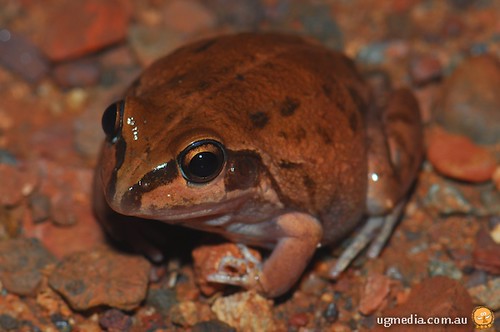
Main's arid frog (Cyclorana maini).
The next day we got the local gossip at the Tom Price visitors' centre before heading out to Karijini National Park.
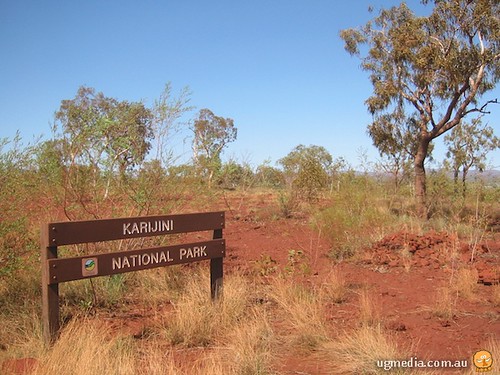
Welcome to Karijini!
Whilst driving around we came across a central military dragon (Ctenophorus isolepis isolepis).
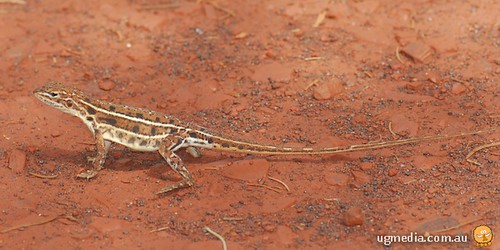
Central military dragon (Ctenophorus isolepis isolepis).
We set up camp and headed to Dales Gorge. It's quite weird to drive through fairly flat, dry and featureless land and then suddenly come across a huge gash in the earth filled with beautiful blue water. Dales Gorge is home to Fortescue Falls, the park's only permanent water fall.

Dale's Gorge, Karijini National Park.
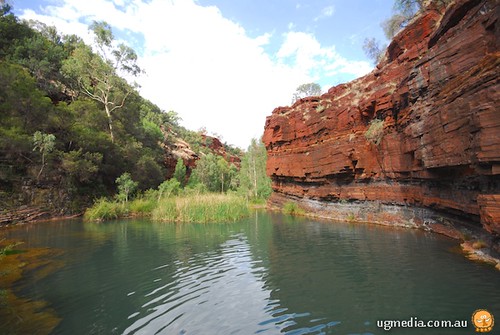
Dale's Gorge, Karijini National Park.
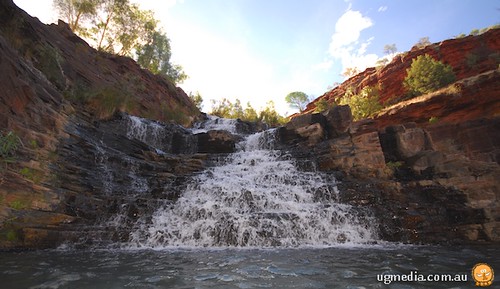
Dale's Gorge, Karijini National Park.
The rocks surrounding the creek were home to many little russet snake-eyed skinks (Cryptoblepharus ustulatus).
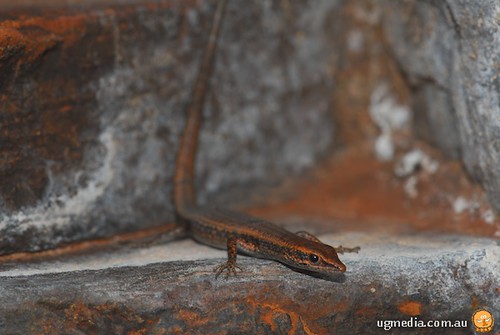
Russet snake-eyed skink (Cryptoblepharus ustulatus).

Russet snake-eyed skink (Cryptoblepharus ustulatus).
This is a newly described species of snake-eyed skink, split off from Cryptoblepharus plagiocephalus in Paul Horner's review of the genus. These little skinks no doubt become fodder for the yellow-spotted monitors (Varanus panoptes) cruising around the gorge.
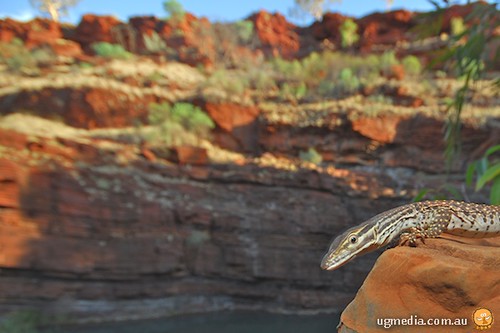
Yellow-spotted monitor (Varanus panoptes).
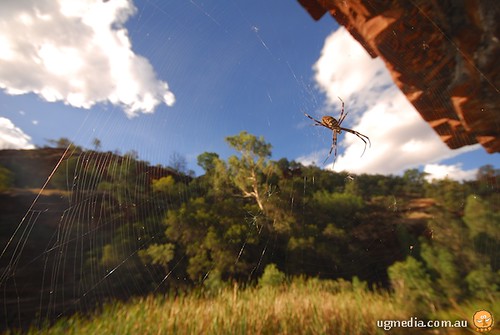
Argiopes spider in web.
That night we went for a drive and found a nice big Pilbara death adder (Acanthophis wellsi), a tiny little Stimson's python (Antaresia stimsoni) and a very scared little button-quail (Turnix velox).
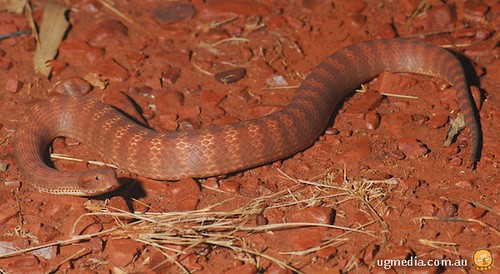
Pilbara death adder (Acanthophis wellsi).

Juvenile stimson's python (Antaresia stimsoni).
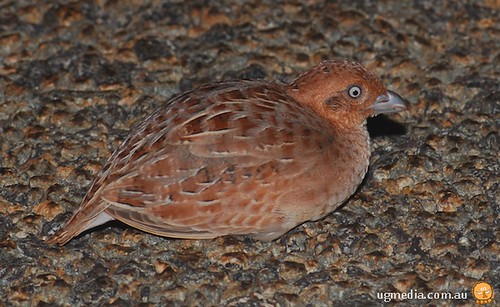
A little button-quail (Turnix velox) on the road at night. He looks a little scared.
The next day we headed to the other side of Dales Gorge to have a look at Fern Pool. Along the way Dean spotted an Egernia formosa sticking his head out of a log.
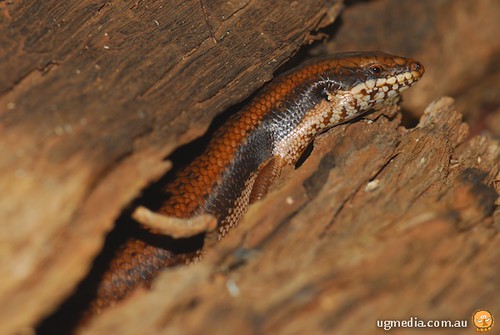
Goldfields crevice-skink (Egernia formosa).
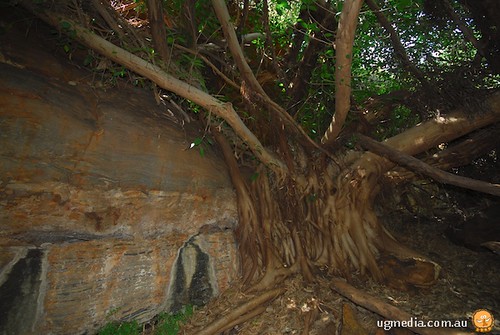
An old, gnarly tree in one of the Karijini gorges.
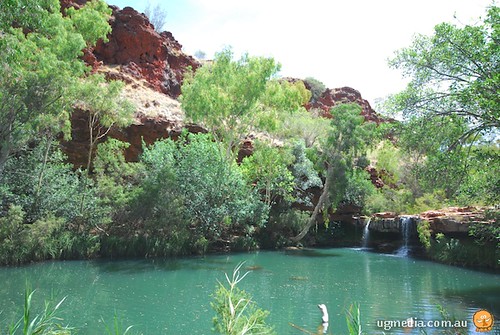
One of the many pools at the bottom of one of the many gorges in Karijini.
Fern Pool was simply gorgeous. We obviously weren't the only ones who thought this, as there was a large yellow-spotted monitor (Varanus panoptes) patrolling the top of a rock face.
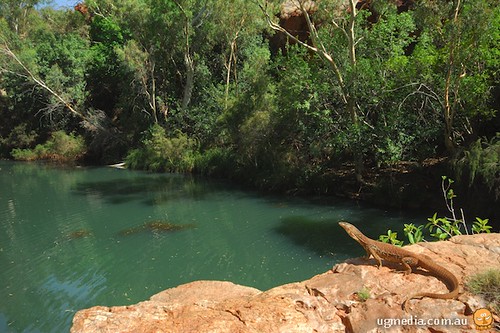
Yellow-spotted monitor (Varanus panoptes).

Yellow-spotted monitor (Varanus panoptes). They stand up when they want to get a better look at you.
The next day we headed across the park to Weano Gorge. We wanted to be there at sunset, but we got there early enough to explore the gorge during the daylight. We climbed down into the gorge and went as far as we could. Along the way I found a black-headed monitor (Varanus tristis) in a rock crevice.
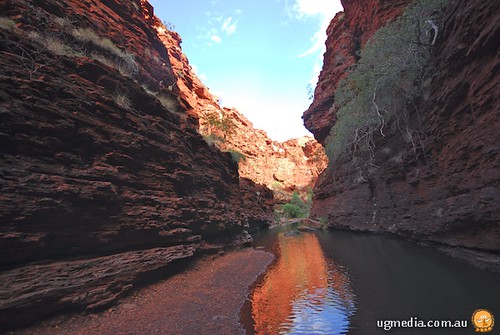
A gorge in Karijini National Park.
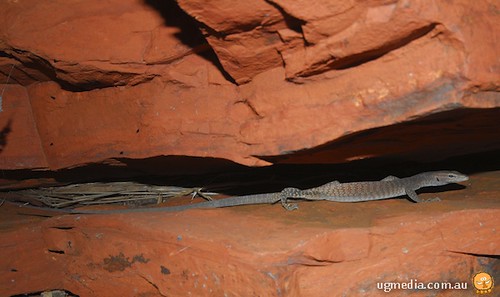
Black-headed monitor (Varanus tristis).
We ended up in a small but deep pool that had hundreds of desert tree frogs (Litoria rubella) lining the edges.
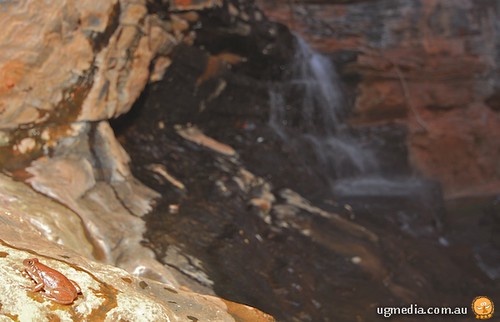
Desert tree frog (Litoria rubella).
Farhan found a little Delma borea that had evidently fallen over the edge or been washed down from further up the gorge. We put it in a sock to carry it to more suitable habitat.
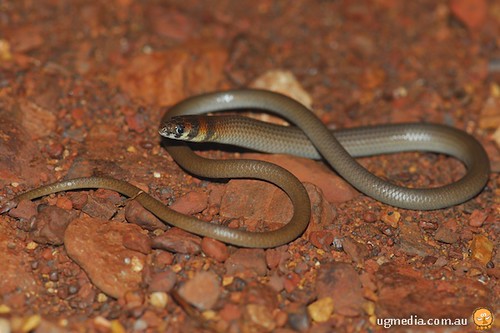
Delma borea, a legless lizard..
As it neared dark we headed back up the gorge. Along the way we saw a heap of Egernia formosa scurrying about, a narrow-banded sand-swimmer (Eremiascincus fasciolatus), a huntsman with stripes on his legs and a small mulga snake (Pseudechis australis) cruising between Farhan's legs.

Egernia formosa.
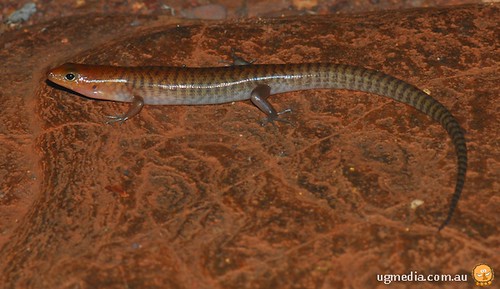
Narrow-banded sand-swimmer (Eremiascincus fasciolatus).
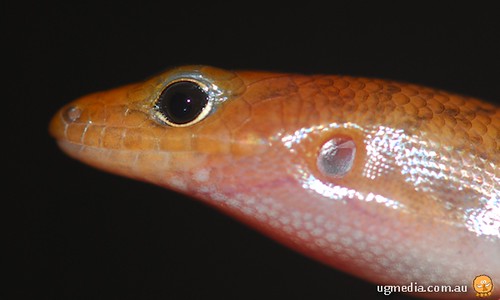
Narrow-banded sand-swimmer (Eremiascincus fasciolatus).
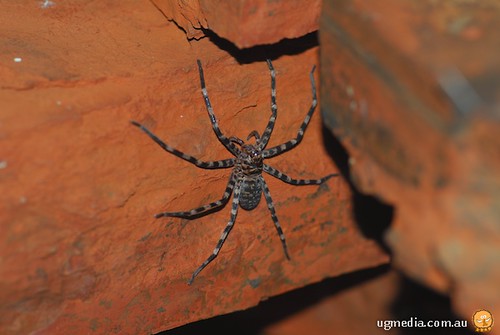
Zebra huntsman.
Up on top of the gorge we found the largest Burton's legless lizard (Lialis burtonis) I've ever seen, along with a Pilbara dtella (Gehyra pilbara).
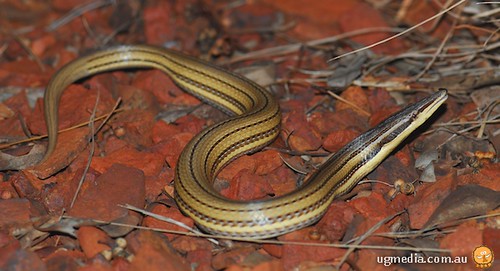
A massive Burton's legless lizard (Lialis burtonis).
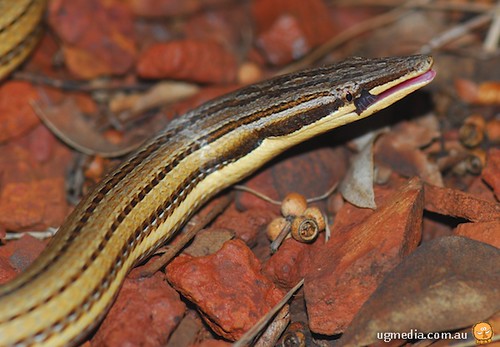
Burton's legless lizard (Lialis burtonis).
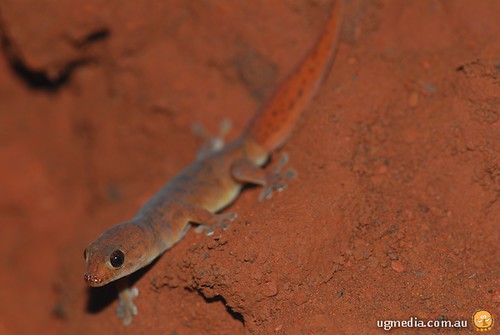
Pilbara dtella (Gehyra pilbara).
On the drive back to the camp we found a centralian blue-tongued skink (Tiliqua multifasciata) on the road.
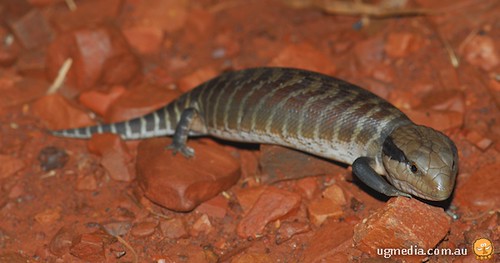
Centralian blue-tongued skink (Tiliqua multifasciata).
On our last day went to another gorge where we finally saw a Pilbara rock monitor (Varanus pilbarensis).
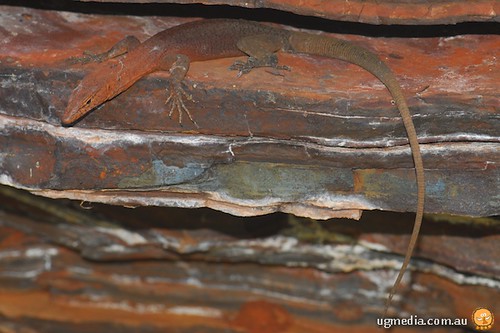
Pilbara rock monitor (Varanus pilbarensis).
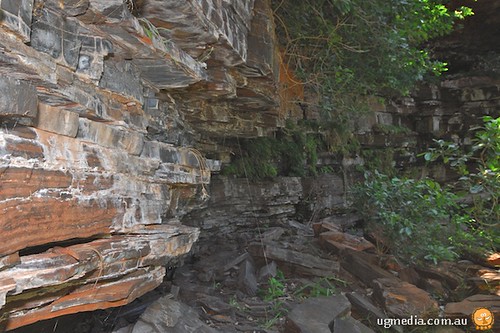
Pilbara rock monitor (Varanus pilbarensis).
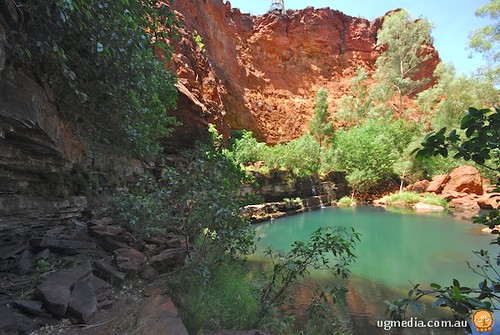
A gorge in Karijini NP.
We left the gorge at about 2 PM and started the long drive home. Along the way we saw a dingo dragging a kangaroo carcass off the road, but we were too slow to get a picture of it with the carcass.
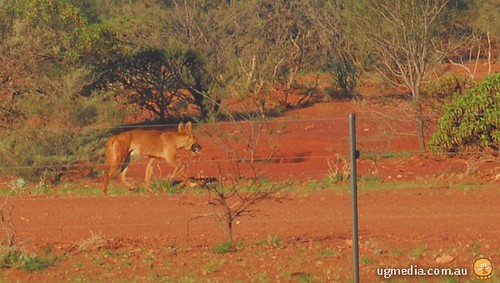
Dingo (Canis familiaris).
We arrived back in Perth at about 6 AM the next morning. I headed back to Brisbane a few days later.
This the final installment from my WA trip. Earlier episodes:
The Pinnacles and Lesueur National Park
Numbat alert!
Perth Zoo
Tiger snakes
Into the Rat's nest
Shark Bay
Monkey Mia and Hamelin Pool
Cape Range National Park and Exmouth
In this exciting episode, join our intrepid adventurers as they battle dragons, serpents, the public health system and much, much more!
On the way from Cape Range to Karijini we drove though a lot of spinifex country and saw a number of dragons dashing off the road as we went by. We stopped and tracked one down to find it was a ring-tailed dragon (Ctenophorus caudicinctus).

Ring-tailed dragon (Ctenophorus caudicinctus).

Ring-tailed dragon (Ctenophorus caudicinctus) habitat.
On the way into Tom Price (the town closest to Karijini) we had a look at a lookout. At the top were piles of rocks with 'in memoriam' inscriptions on them. These rocks are apparently placed here to honour those that have died in the local mines.

A rock pile memorial on top of a hill near Tom Price. The writings on the rocks honour those people who have died in the nearby mines.

Some rocks honour other, non-mining related tragedies..
The sun went down before we got to town, so we drove the last 30 minutes or so in the dark. This worked out well as we saw a number of cool reptiles on the road, including the other snake I'd come to Western Australia for, the pygmy python (Antaresia perthensis).

Pygmy python (Antaresia perthensis), the world's smallest python..

Pygmy python (Antaresia perthensis).
I also added another spiny-tailed gecko to my list when we found a Strophurus wellingtonae.

Strophurus wellingtonae.
Sadly, there were a number of dead or dying snakes on the road, such as a western brown snake (Pseudonaja nuchalis) and this orange-naped snake (Furina ornata).

Road-killed orange-naped snake (Furina ornata).
We also found a still-writhing Pilbara death adder (Acanthophis wellsi).

This Pilbara death adder (Acanthophis wellsi) had just been hit by a car. We crushed its head to put it down..
Dean grabbed a nearby rock and went to crush its head to put it out of its misery. As he did so, the snake flinched and brushed against his hand. We weren't sure if he'd been bitten or not, so we bandaged his arm and headed to the Tom Price hospital. Thankfully we were only a few minutes away from town by this stage. We rocked up at the hospital and told them they story. Dean wasn't showing any signs of envenomation so they took the bandage off and monitored his vital signs. After a few minutes of normality the nurse was satisfied that Dean hadn't been bitten, so we left.
It was a bit late to make it to Karijini so we headed to the nearby caravan park and set up camp. Because we'd had such a good haul on the road we decided to head back out and see what else was active. We soon came across a sleeping ring-tailed dragon (Ctenophorus caudicinctus).

Ring-tailed dragons (Ctenophorus caudicinctus) often sleep on the road at night..
As we were photographing it Dean saw a snake crossing the road ahead so we all sprinted up to find a beautifully patterned Stimson's python (Antaresia stimsoni) arcing up in our presence.

Stimson's python (Antaresia stimsoni).

Stimson's python (Antaresia stimsoni).
Back at the caravan park we found a Main's arid frog (Cyclorana maini) and finally went to sleep.

Main's arid frog (Cyclorana maini).
The next day we got the local gossip at the Tom Price visitors' centre before heading out to Karijini National Park.

Welcome to Karijini!
Whilst driving around we came across a central military dragon (Ctenophorus isolepis isolepis).

Central military dragon (Ctenophorus isolepis isolepis).
We set up camp and headed to Dales Gorge. It's quite weird to drive through fairly flat, dry and featureless land and then suddenly come across a huge gash in the earth filled with beautiful blue water. Dales Gorge is home to Fortescue Falls, the park's only permanent water fall.

Dale's Gorge, Karijini National Park.

Dale's Gorge, Karijini National Park.

Dale's Gorge, Karijini National Park.
The rocks surrounding the creek were home to many little russet snake-eyed skinks (Cryptoblepharus ustulatus).

Russet snake-eyed skink (Cryptoblepharus ustulatus).

Russet snake-eyed skink (Cryptoblepharus ustulatus).
This is a newly described species of snake-eyed skink, split off from Cryptoblepharus plagiocephalus in Paul Horner's review of the genus. These little skinks no doubt become fodder for the yellow-spotted monitors (Varanus panoptes) cruising around the gorge.

Yellow-spotted monitor (Varanus panoptes).

Argiopes spider in web.
That night we went for a drive and found a nice big Pilbara death adder (Acanthophis wellsi), a tiny little Stimson's python (Antaresia stimsoni) and a very scared little button-quail (Turnix velox).

Pilbara death adder (Acanthophis wellsi).

Juvenile stimson's python (Antaresia stimsoni).

A little button-quail (Turnix velox) on the road at night. He looks a little scared.
The next day we headed to the other side of Dales Gorge to have a look at Fern Pool. Along the way Dean spotted an Egernia formosa sticking his head out of a log.

Goldfields crevice-skink (Egernia formosa).

An old, gnarly tree in one of the Karijini gorges.

One of the many pools at the bottom of one of the many gorges in Karijini.
Fern Pool was simply gorgeous. We obviously weren't the only ones who thought this, as there was a large yellow-spotted monitor (Varanus panoptes) patrolling the top of a rock face.

Yellow-spotted monitor (Varanus panoptes).

Yellow-spotted monitor (Varanus panoptes). They stand up when they want to get a better look at you.
The next day we headed across the park to Weano Gorge. We wanted to be there at sunset, but we got there early enough to explore the gorge during the daylight. We climbed down into the gorge and went as far as we could. Along the way I found a black-headed monitor (Varanus tristis) in a rock crevice.

A gorge in Karijini National Park.

Black-headed monitor (Varanus tristis).
We ended up in a small but deep pool that had hundreds of desert tree frogs (Litoria rubella) lining the edges.

Desert tree frog (Litoria rubella).
Farhan found a little Delma borea that had evidently fallen over the edge or been washed down from further up the gorge. We put it in a sock to carry it to more suitable habitat.

Delma borea, a legless lizard..
As it neared dark we headed back up the gorge. Along the way we saw a heap of Egernia formosa scurrying about, a narrow-banded sand-swimmer (Eremiascincus fasciolatus), a huntsman with stripes on his legs and a small mulga snake (Pseudechis australis) cruising between Farhan's legs.

Egernia formosa.

Narrow-banded sand-swimmer (Eremiascincus fasciolatus).

Narrow-banded sand-swimmer (Eremiascincus fasciolatus).

Zebra huntsman.
Up on top of the gorge we found the largest Burton's legless lizard (Lialis burtonis) I've ever seen, along with a Pilbara dtella (Gehyra pilbara).

A massive Burton's legless lizard (Lialis burtonis).

Burton's legless lizard (Lialis burtonis).

Pilbara dtella (Gehyra pilbara).
On the drive back to the camp we found a centralian blue-tongued skink (Tiliqua multifasciata) on the road.

Centralian blue-tongued skink (Tiliqua multifasciata).
On our last day went to another gorge where we finally saw a Pilbara rock monitor (Varanus pilbarensis).

Pilbara rock monitor (Varanus pilbarensis).

Pilbara rock monitor (Varanus pilbarensis).

A gorge in Karijini NP.
We left the gorge at about 2 PM and started the long drive home. Along the way we saw a dingo dragging a kangaroo carcass off the road, but we were too slow to get a picture of it with the carcass.

Dingo (Canis familiaris).
We arrived back in Perth at about 6 AM the next morning. I headed back to Brisbane a few days later.
Last edited:






